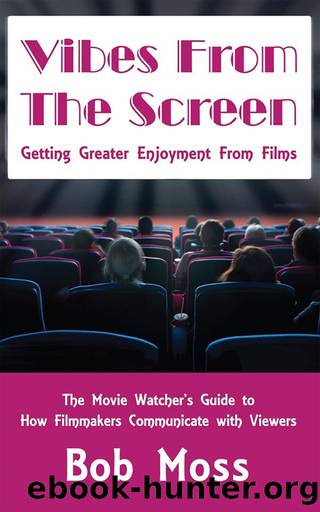Vibes From The Screen by Moss Bob;

Author:Moss, Bob;
Language: eng
Format: epub
ISBN: 978-1-63505-289-3
Publisher: MCP Books
Mise-en-scène and Framing
The arrangement of everything that appears in the framingâthe actors, lighting, space, decor, props, costumesâis called mise-en-scène, a French term that means âstaging or putting on an action or scene.â (It is also called a full-screen shot.) The frame, its composition, and the camera work also constitute part of the mise-en-scène of a movie. The mise-en-scène is the end result of the efforts of many professionals. It is what appears within a shot or a scene and where the audienceâs experience begins.
The mise-en-scène encompasses the relationship between the film elements and affects the viewerâs perception, mood, and emotions. When looking at a scene, consider whether or not the combination of all these elements aid your understanding of the story and/or the characters. Does the mise-en-scène convey meaning of the shot or scene? Occasionally, the mise-en-scène will create the impression of something opposite to what you expected. This might be intentional, such as in a suspense movie that is giving you false clues. The majority of the time, however, it is complementary to the narrative. Pay attention to everything you see in a shot because something on the fringe of that shot might be a clue to what will come or may help explain something.
Another technique to be aware of is the frame composition. When composing a shot, what the director or cinematographer choose to frame has a direct impact on the viewerâs emotional response. The placement of the frame has a certain effect on the characters and a different effect on the viewers. A tight, close-in frame places constraints on the characters movementsâthey are trapped, literally and figuratively. The viewers, however, are pulled into the shot and experience an intimacy with the scene. They become a part of the event, not just spectators. Using a closed-frame composition pulls our focus into the frame and leads to a stronger emotional response because there is no thought of what might be outside the frame. Son of Saul (2015) was shot on 35mm. film using a 45mm. lens. Cinematographer Mátyás Erdély then used a very soft focus blurring most of what was behind the character(s). The overall effect was that the viewer feels squeezed into the location with no room to explore. It is very dramatic and effective at conveying the message.
In contrast, an open-frame composition lets the viewer wander around the entire frame and implies there is more than we can see. A wide, open shot allows for the development of the scene. It denotes a certain freedom for the actors and the cameraman. The viewer is now more of an observer waiting to be directed. There is an underlying tension waiting to be released. The classic scene of all the wounded soldiers lying side by side in the train yard in Gone With the Wind (1939) makes us believe that more people are there, but we just cannot see them. Compare that scene with the scene in Ida (2014), in which we are drawn straight into the frame and made to feel restricted as to where we can look.
Download
This site does not store any files on its server. We only index and link to content provided by other sites. Please contact the content providers to delete copyright contents if any and email us, we'll remove relevant links or contents immediately.
30 Movies to Get You Through the Holidays by Roger Ebert(353)
Naked as Nature Intended by Pamela Green(352)
How To Write A Damn Good Thriller by James N. Frey(329)
Bond, James Bond by Brad Gilmore(281)
It's Only a Movie! by Haberski Jr. Raymond J(262)
Chinese films in focus II by Unknown(244)
The Fellowship of the Knits: Lord of the Rings: The Unofficial Knitting Book by Tanis Gray(236)
How To Write A Novel The Easy Way Using The Pulp Fiction Method To Write Better Novels: Writing Skills by Jim Driver(218)
The Greatest Show on Earth by Jerry Pinto(214)
Film Truth; November, 1920 by Anonymous(200)
The Garden in the Machine by Unknown(198)
Smartphone Cinema: Making Great Films with Your Mobile Phone by Bart Weiss(196)
The Reel Truth by Reed Martin(193)
Jafar Panahi: Interviews by Unknown(187)
Charles McGraw by Alan K. Rode(186)
Jurassic Park and Philosophy by Watkins Jessica Michaud Nicolas(185)
Euro-Visions: Europe in Contemporary Cinema by Mariana Liz(183)
Black Static #43 Horror Magazine (Nov--Dec 2014) by 2014 Nov-Dec (retail) (epub)(183)
The Japanese Cinema Book by Hideaki Fujiki & Alastair Phillips(175)
